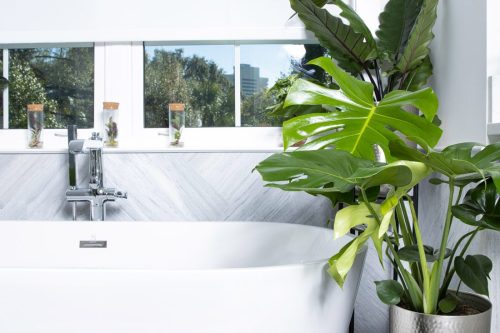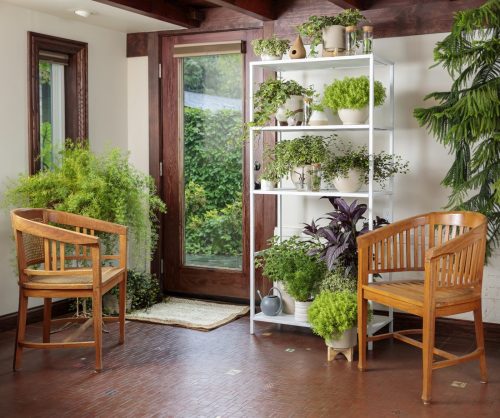If you’ve been growing houseplants outdoors this summer, now may be the time to start moving them indoors. Once temperatures start consistently dipping below 60°F, the plants can begin to shut down and drop leaves, so aim to get them moved back inside before then. Below we share our top tips for bringing houseplants indoors for the winter.
Things to Consider Before Moving Plants Inside
Before you start the work of moving your houseplants back inside, consider these questions.
- Does this kind of plant grow well indoors as a houseplant?
- Do you have room for it in your house? Will it fit through your door?
- Do you have a spot where it will receive enough light? If not, are you willing to use grow lights?
- Do you want to spend the time watering and caring for it all winter?
If your answer is yes to all of the above questions, keep reading.

Steps to Bringing Your Houseplants Indoors for Winter
We’ll describe the general process for moving plants indoors here and give you some options to modify the steps to fit your comfort level. This isn’t an exact science. Most of the time, plants respond very well when moved indoors using these steps. But sometimes, the stress of changing the environment is just too much or the conditions indoors aren’t right to keep a plant happy. If that happens, try again with a different type of plant next time.
1. Inspect and Treat for Pests and Diseases.
You only want to bring healthy, pest-free plants into your home. So, take a close look at your plant’s leaves, stems and rootball before you go any further. If there are signs of pests or diseases, choose a different one to bring inside.
Pests and their eggs have a way of hiding down in the nooks and crannies of a plant’s stems and in the soil. Here are a few options for eliminating them before bringing your plants inside.
Soak the whole plant. Add a few drops of a mild dish soap to a bucket of cool water and set the entire plant down in it. Leave it for about 15 to 30 minutes. After that time, the bugs will be killed off and they, along with dead leaves and other things you don’t want to bring inside, will float to the top. Skim them off the water’s surface and discard them.
Wash the foliage and roots. Unpot your plant, then use your hose to spray down all of the plant’s foliage, stems and roots, washing away most or all of the soil. Essentially, you are bare rooting your plant in order to eliminate any unwanted hitchhikers from coming inside with the soil.
Spray with insecticidal soap. If your plant is fragile and its stems or leaves break off easily, this is the least invasive approach. However, it is not as thorough as soaking or washing your plant. Use an organic insecticidal soap to spray down the entire plant and soak the soil. This should kill any insects and eggs that are present.
After washing or treating your plant, scrub the pot. There’s no need to bring in any dirt, debris or bacteria, and washing your pot will help eliminate those things. If you were using a saucer for it outdoors, clean that up as well.
2. Remove Any Brown or Tattered Leaves.
Once your plant is washed up and you can clearly see its foliage, remove any leaves that are brown, tattered or generally look unhealthy. If it was a flowering houseplant, deadhead any spent flower stems. You only want to bring the healthiest parts of your plant indoors.
3. Repot Your Plant.
This step will be necessary if you chose to bare root your plant and remove its soil in step one. Use fresh potting soil to repot your plant into its original container. Succulent and orchid potting mixes are available for those houseplants which have special soil requirements.
If the plant you are bringing indoors was growing in a mixed planter with other things you aren’t saving, choose a new pot that is only slightly larger than the plant’s rootball. Water it in well to eliminate any air pockets.
4. Acclimate Your Plant If You Have Time.
If can be jarring to a plant to completely change its growing environment overnight. To help ease the transition, it’s a good idea to start the process a week or two before outdoor temperatures necessitate a move indoors.
Acclimate your plant by moving it into a shadier area outdoors or bring the plant into an unheated porch or garage at night and back outdoors during the day. Continue this process for a week or two in order to acclimate the plant to its new lower light environment.
However, if the forecast calls for temps in the 40s tonight and you just remembered that you still need to bring your plants indoors, haul them inside now before it is too late. Tomorrow, when it is warmer again, bring them back outside to complete steps one through three.
5. Choose a Suitable Location Indoors for Your Houseplant.
Check the label or look online to find your plant’s lighting requirements so you can find the best spot for it in your house. Avoid placing plants near cold drafts and heating vents.
If your plant requires high light like succulents do, choose a south or west-facing windowsill or table where it will receive direct sunlight. If its light needs are medium or bright indirect, look for a spot within a few feet of an east or west-facing window. If it has low light needs, it can be placed further away from a window, but not in a dark corner. All plants need some light to grow.
Most leafy houseplants are native to warm, humid climates. They can often suffer from dry air in your house over the winter months when you can’t open the windows and let in some humidity. Alleviate this issue by running a humidifier in the room where your plants are growing or placing the plant’s pot on top of a saucer filled with pebbles and water. The water will evaporate slowly, raising the humidity around the plant. Misting plants, while certainly trendy on social media, does little to raise the humidity around the plant for more than a few minutes.

What To Expect When You Bring Your Houseplants Indoors for Winter
Don’t be surprised if and when the following things happen when you bring your houseplants indoors. In most cases, the effect is temporary and won’t be detrimental to the plant.
- Dropping leaves – a response to changing light levels as the plant gets acclimated
- Yellowing leaves – a response to lower light and overwatering
- Brown edges developing on the leaves – a response to low humidity, uneven watering or notenough moisture
- Dropping flowers – a response to lower light levels
- Plant collapse – not a good sign; can be due to lack of light, overwatering, stress of moving, etc.
Ready to shop for some new houseplants? See our collection of leafjoyTM houseplants from Proven Winners.
